
Norian
Encyclopedia
The Norian is a division of the Triassic
geological period. It has the rank of an age (geochronology
) or stage (chronostratigraphy
). The Norian lasted from 216.5 ± 2.0 to 203.6 ± 1.5 million years ago. It was preceded by the Carnian
and succeeded by the Rhaetian
.
in Austria
. The stage was introduced into scientific literature by Austrian geologist Edmund Mojsisovics von Mojsvar in 1869.
The Norian stage begins at the base of the ammonite
biozone
s of Klamathites macrolobatus and Stikinoceras kerri, and at the base of the conodont
biozones of Metapolygnathus communisti and Metapolygnathus primitius. A global reference profile for the base (a GSSP) had in 2009 not yet been appointed.
The top of the Norian (the base of the Rhaetian) is at the first appearance of ammonite species Cochloceras amoenum. The base of the Rheatian is also close to the first appearance of conodont species Misikella spp. and Epigondolella mosheri and the radiolarid species Proparvicingula moniliformis.
In the Tethys domain
, the Norian stage contains six ammonite biozones:
.; 2008: Lithostratigraphy, chemostratigraphy, and vertebrate biostratigraphy of the Dockum Group (Upper Triassic), of southern Garza County, West Texas, Doctoral Dissertation, Texas Tech.
Triassic
The Triassic is a geologic period and system that extends from about 250 to 200 Mya . As the first period of the Mesozoic Era, the Triassic follows the Permian and is followed by the Jurassic. Both the start and end of the Triassic are marked by major extinction events...
geological period. It has the rank of an age (geochronology
Geochronology
Geochronology is the science of determining the age of rocks, fossils, and sediments, within a certain degree of uncertainty inherent to the method used. A variety of dating methods are used by geologists to achieve this, and schemes of classification and terminology have been proposed...
) or stage (chronostratigraphy
Chronostratigraphy
Chronostratigraphy is the branch of stratigraphy that studies the age of rock strata in relation to time.The ultimate aim of chronostratigraphy is to arrange the sequence of deposition and the time of deposition of all rocks within a geological region, and eventually, the entire geologic record of...
). The Norian lasted from 216.5 ± 2.0 to 203.6 ± 1.5 million years ago. It was preceded by the Carnian
Carnian
The Carnian is the lowermost stage of the Upper Triassic series . It lasted from about 228.7 till 216.5 million years ago . The Carnian is preceded by the Ladinian and is followed by the Norian...
and succeeded by the Rhaetian
Rhaetian
The Rhaetian is in geochronology the latest age of the Triassic period or in chronostratigraphy the uppermost stage of the Triassic system. It lasted from 203.6 ± 1.5 to 199.6 ± 0.6 million years ago...
.
Stratigraphic definitions
The Norian was named after the Noric AlpsNoric Alps
The Noric Alps are a mountain range in the Eastern Alps located mostly in Austria with a small area in Slovenia...
in Austria
Austria
Austria , officially the Republic of Austria , is a landlocked country of roughly 8.4 million people in Central Europe. It is bordered by the Czech Republic and Germany to the north, Slovakia and Hungary to the east, Slovenia and Italy to the south, and Switzerland and Liechtenstein to the...
. The stage was introduced into scientific literature by Austrian geologist Edmund Mojsisovics von Mojsvar in 1869.
The Norian stage begins at the base of the ammonite
Ammonite
Ammonite, as a zoological or paleontological term, refers to any member of the Ammonoidea an extinct subclass within the Molluscan class Cephalopoda which are more closely related to living coleoids Ammonite, as a zoological or paleontological term, refers to any member of the Ammonoidea an extinct...
biozone
Biozone
Biostratigraphic units or Biozones are intervals of geological strata that are defined on the basis of their characteristic fossil taxa....
s of Klamathites macrolobatus and Stikinoceras kerri, and at the base of the conodont
Conodont
Conodonts are extinct chordates resembling eels, classified in the class Conodonta. For many years, they were known only from tooth-like microfossils now called conodont elements, found in isolation. Knowledge about soft tissues remains relatively sparse to this day...
biozones of Metapolygnathus communisti and Metapolygnathus primitius. A global reference profile for the base (a GSSP) had in 2009 not yet been appointed.
The top of the Norian (the base of the Rhaetian) is at the first appearance of ammonite species Cochloceras amoenum. The base of the Rheatian is also close to the first appearance of conodont species Misikella spp. and Epigondolella mosheri and the radiolarid species Proparvicingula moniliformis.
In the Tethys domain
Tethys Ocean
The Tethys Ocean was an ocean that existed between the continents of Gondwana and Laurasia during the Mesozoic era before the opening of the Indian Ocean.-Modern theory:...
, the Norian stage contains six ammonite biozones:
- zone of Halorites macer
- zone of Himavatites hogarti
- zone of Cyrtopleurites bicrenatus
- zone of Juvavites magnus
- zone of Malayites paulckei
- zone of Guembelites jandianus
Dinosaurs
| Dinosaur Dinosaur Dinosaurs are a diverse group of animals of the clade and superorder Dinosauria. They were the dominant terrestrial vertebrates for over 160 million years, from the late Triassic period until the end of the Cretaceous , when the Cretaceous–Paleogene extinction event led to the extinction of... s of the Norian |
||||
|---|---|---|---|---|
| Taxa | Presence | Location | Description | Images |
|
    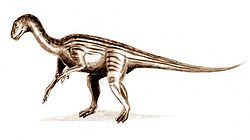 |
|||
|
Late Carnian Carnian The Carnian is the lowermost stage of the Upper Triassic series . It lasted from about 228.7 till 216.5 million years ago . The Carnian is preceded by the Ladinian and is followed by the Norian... to early Norian |
Ghost Ranch Ghost Ranch Ghost Ranch is a retreat and education center located close to the village of Abiquiu in Rio Arriba County in north central New Mexico. The conference center and lodgings at Ghost Ranch are run by the Presbyterian Church but open to the general public.-History:Ghost Ranch is part of Piedra... , New Mexico, USA |
||
|
Liliensternus Liliensternus was a genus of coelophysoid dinosaur from the Late Triassic period, about 205 Ma.Liliensternus was originally named in 1934 by Friedrich von Huene as a second species of Halticosaurus, H. liliensterni, the specific name honouring the German amateur paleontologist, Dr... |
||||
|
Plateosaurus Plateosaurus is a genus of plateosaurid dinosaur that lived during the Late Triassic period, around 216 to 199 million years ago, in what is now Central and Northern Europe. Plateosaurus is a basal sauropodomorph dinosaur, a so-called "prosauropod"... |
||||
|
Thecodontosaurus Thecodontosaurus is a genus of herbivorous basal sauropodomorph dinosaur which lived during the late Triassic period .... |
Norian/Rhaetian Rhaetian The Rhaetian is in geochronology the latest age of the Triassic period or in chronostratigraphy the uppermost stage of the Triassic system. It lasted from 203.6 ± 1.5 to 199.6 ± 0.6 million years ago... |
|||
†Pterosaurs
| Pterosaur Pterosaur Pterosaurs were flying reptiles of the clade or order Pterosauria. They existed from the late Triassic to the end of the Cretaceous Period . Pterosaurs are the earliest vertebrates known to have evolved powered flight... s of the Norian |
||||
|---|---|---|---|---|
| Taxa | Presence | Location | Description | Images |
|
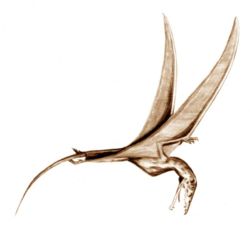 |
|||
|
||||
|
Preondactylus Preondactylus is a genus of long-tailed pterosaur from the Late Triassic that inhabited what is now Italy. It was discovered by Nando Buffarini in 1982 near Udine in the Preone valley of the Italian Alps.-Anatomy:... |
||||
Crocodylomorphs
| Crocodylomorphs Crocodylomorpha The Crocodylomorpha are an important group of archosaurs that include the crocodilians and their extinct relatives.During Mesozoic and early Tertiary times the Crocodylomorpha were far more diverse than they are now. Triassic forms were small, lightly built, active terrestrial animals. These were... of the Norian |
||||
|---|---|---|---|---|
| Taxa | Presence | Location | Description | Images |
|
 |
|||
†Ichthyosaurs
| Ichthyosaur Ichthyosaur Ichthyosaurs were giant marine reptiles that resembled fish and dolphins... s of the Norian |
||||
|---|---|---|---|---|
| Taxa | Presence | Location | Description | Images |
Shonisaurus
|
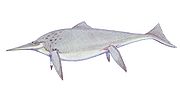 |
|||
†Dinosauromorphs (non-dinosaurian)
| †Non-dinosaurian Paraphyly A group of taxa is said to be paraphyletic if the group consists of all the descendants of a hypothetical closest common ancestor minus one or more monophyletic groups of descendants... dinosauromorphs Dinosauromorpha Dinosauromorpha is the name of a clade of archosaurs that includes the closest relatives of dinosaurs, and the order Dinosauria itself. Basal forms include Saltopus, Marasuchus, the perhaps identical Lagosuchus, the lagerpetonids Lagerpeton from the Ladinian of Argentina and Dromomeron from the... of the Norian |
||||
|---|---|---|---|---|
| Taxa | Presence | Location | Description | Images |
|
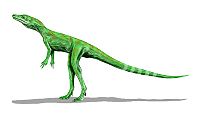 |
|||
|
Eucoelophysis Eucoelophysis is a genus of dinosauriform from the Late Triassic period Chinle Formation of New Mexico... |
New Mexico | |||
†Placodonts
| Placodont Placodont Placodonts were a group of marine reptiles that lived during the Triassic period, becoming extinct at the end of the period. It is believed that they were part of Sauropterygia, the group that includes Plesiosaurs... s of the Norian |
||||
|---|---|---|---|---|
| Taxa | Presence | Location | Description | Images |
|
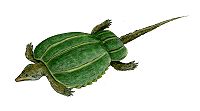 |
|||
†Crurotarsans (non-crocodylomorph)
| †Non-crocodylomorph Paraphyly A group of taxa is said to be paraphyletic if the group consists of all the descendants of a hypothetical closest common ancestor minus one or more monophyletic groups of descendants... Crurotarsans Crurotarsi The Crurotarsi are a group of archosauriformes, represented today by the crocodiles,... of the Carnian |
||||
|---|---|---|---|---|
| Taxa | Presence | Location | Description | Images |
|
 |
|||
|
Teratosaurus Teratosaurus was a genus of rauisuchian known from the Triassic Stubensandstein of Germany... |
||||
Mammaliaformes
| Mammaliaformes Mammaliaformes Mammaliaformes is a clade that contains the mammals and their closest extinct relatives. Phylogenetically, it is defined as a clade including the most recent common ancestor of Sinoconodon, morganuconodonts, docodonts, Monotremata, Marsupialia, Placentalia, extinct members of this clade, and all... of the Carnian |
||||
|---|---|---|---|---|
| Taxa | Presence | Location | Description | Images |
|
||||
|
Kuehneotherium Kuehneotherium was an early symmetrodont whose fossils have been found in Greenland, France and Luxembourg. It is known only from an upper molar as well as nine additional teeth and four dentary fragments.-Further reading:... |
From Norian to Sinemurian Sinemurian In the geologic timescale, the Sinemurian is an age or stage in the Early or Lower Jurassic epoch or series. It spans the time between 196.5 ± 2 Ma and 189.6 ± 1.5 Ma... |
Greenland and Western Europe | A Late Triassic-Early Jurassic symmetrodonta Symmetrodonta Symmetrodonta is a basal group of Mesozoic mammals characterized by the triangular aspect of the molars when viewed from above and the absence of a well-developed talonid. The traditional group of symmetrodonts ranges in age from the latest Triassic to the Late Cretaceous. One species,... n. |
|
|
Morganucodon Morganucodon is an early mammalian genus which lived during the Late Triassic. It first appeared about 205 million years ago. This has also been identified with Eozostrodon. Unlike many other early mammals, Morganucodon is well represented by abundant and well preserved, though in the vast... |
||||
|
|
||||
Literature
; 2005: The Global boundary Stratotype Section and Point (GSSP) of the Ladinian Stage (Middle Triassic) at Bagolino (Southern Alps, Northern Italy) and its implications for the Triassic time scale, Episodes 28(4), pp. 233-244.; 2004: A Geologic Time Scale 2004, Cambridge University PressCambridge University Press
Cambridge University Press is the publishing business of the University of Cambridge. Granted letters patent by Henry VIII in 1534, it is the world's oldest publishing house, and the second largest university press in the world...
.; 2008: Lithostratigraphy, chemostratigraphy, and vertebrate biostratigraphy of the Dockum Group (Upper Triassic), of southern Garza County, West Texas, Doctoral Dissertation, Texas Tech.
External links
- GeoWhen Database - Norian
- Upper Triassic timescale, at the website of the subcommission for stratigraphic information of the ICS
- Norges Network of offshore records of geology and stratigraphy: Stratigraphic charts for the Triassic, http://norges.uio.no/timescale/Late_Triassic.pdf and http://norges.uio.no/timescale/Fig16.1_Tri_colA.pdf

